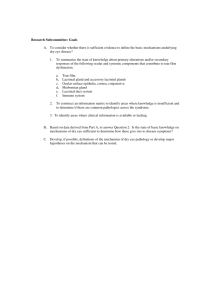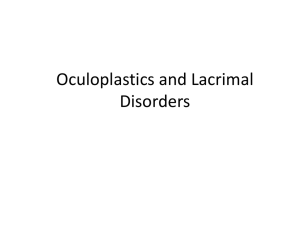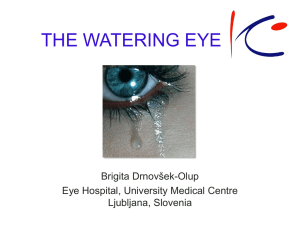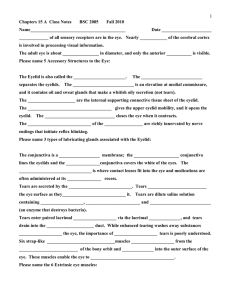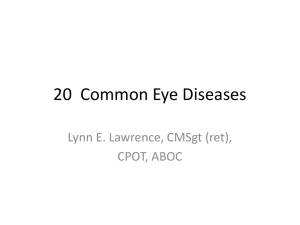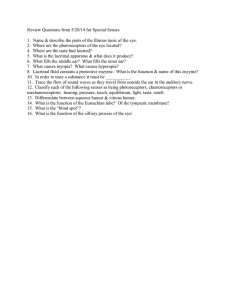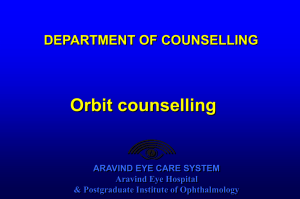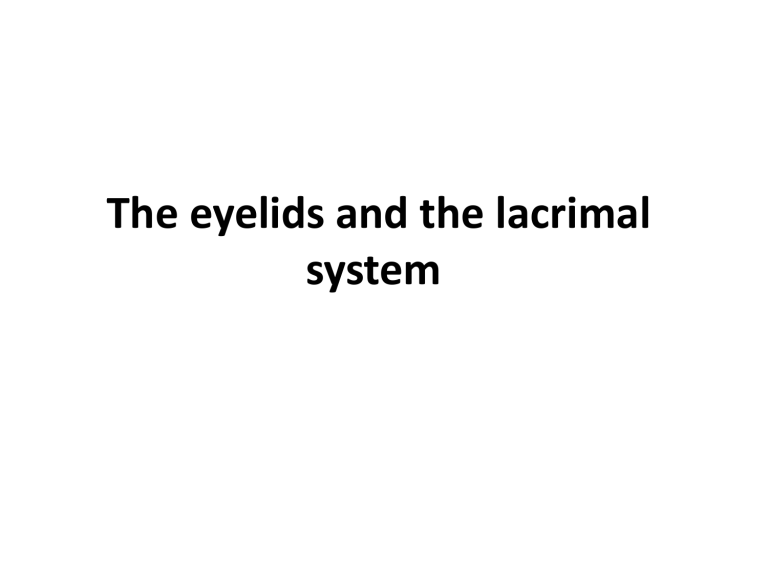
The eyelids and the lacrimal system Eyelid layers : 1- skin: thin and loose 2- fascia: contains orbicularis oculi muscle. 3- tarsus: -dense fibrous tissue -Levator palpebrae superioris inserts on superior tarsal plate. -medial and lateral palpebral ligaments attached to its medial and lateral border. 4-palpebral conjunctiva. Eyelid anatomy Innervation of Eyelids The opthalmic and maxillary divisions of the trigeminal nerve provide sensory innervation of the eyelids. Motor control of the orbicularis muscle is through the facial nerve, and that of the levator muscle is through the oculomotor nerve. The tarsal smooth muscles are innervated by sympathetic fibers from the superior cervical ganglion Blood supply the eyelids are supplied with blood by two arches on each upper and lower lid. The arches are formed by anastomoses of the lateral palpebral arteries and medial palpebral arteries, branching off from the lacrimal artery and ophthalmic artery, respectively. The Eyelids Benign nodules and cyst Inflammatory diseases of the eyelid Benign and malignant tumors Malposition of the eyelid and eyelashes Benign nodules and cyst 1-chalazion -non-infectious painless swelling of the eyelid. -appears as a slow growing lump. -due to the obstruction of the ducts of sebaceous glands. Chalazion Risk factors: Chalazia are more common in people with inflammatory conditions like seborrhea, acne, rosacea, chronic blepharitis. Treatment: Some chalazia can go away without treatment. -Home care: apply a warm compress. -Medical treatment: abx-steroid combination. -Surgical: Incision and curettage. 2- hordeolum: an infectious painful swelling of the eyelid due to obstrucion of the duct of sebaceous gland Hordeolum externum (stye) -Acute suppurative infection of the zeis gland mostly by S.Aureus Treatment : 1-analgesic to relieve pain. 2-topical + systemic antibiotic. 3-abcess drainage and associated eyelash should be pulled out. 4-warm compresses to improve drainage. Hordeolum internum -acute suppurative infction of the meibomien gland mosly by S.Aureus. - More diffuse than stye. Treatment : 1-analgesic. 2-topical + systemic antibiotic. 3-warm compresses to improve drainage. Blepharitis: chronic inflammation of the eyelid Anterior Blepharitis: inflammation involves the lid margin, skin, and eyelash follicles . Posterior blepharitis: inflammation involves the meibomian glands. Blepheritis -Blepharitis is often a chronic condition that is difficult to treat. - it's not contagious. - In severe disease the corneal epithelium is affected (blepharokeratitis); Small ulcers may form in the peripheral cornea (marginal ulceration secondary to staphylococcal exotoxins). Symptoms : Watery eyes Red eyes Eyelids that appear greasy Itchy eyelids Red, swollen eyelids Flaking of the skin around the eyes Crusted eyelashes upon awakening Eyelid sticking More frequent blinking Eyelashes that grow abnormally (misdirected eyelashes) Loss of eyelashes Blepheritis The exact cause of blepharitis isn't clear. It may be associated with one or more factors, including: -Seborrheic dermatitis -A bacterial infection -Clogged or malfunctioning oil glands in your eyelids -Rosacea -Allergies to eye medications, contact lens solutions or eye makeup -Eyelash mites or lice Treatmet: -treat underlying cause -eyelid toileting -topical steroid -Topical antibiotic -artificial tears Malposition of the eyelid and eyelashes 1-Entropion 2-Ectropion 3-Ptosis 4-Blepharospasm 5-Trichiasis 6-Distichiasis 1-entropion Entropion -A condition in which the eyelid (usually the lower lid) inverts toward the globe. It is very uncomfortable, as the eyelashes continuously rub against the cornea causing irritation, redness, watery eye and might also cause corneal abrasion. -It is seen most commonly in elderly patients where the orbicularis muscle becomes weakened. Other causes: scars, infection, inflammation -Complication: corneal erosion and ulcer. -Treatment: Short-term treatment includes the application of lubricants to the eye or taping the lid to overcome the lid inversion. Permanent treatment requires surgery, in which excess skin of the outer lids is removed or tendons and muscles are shortened 2-Ectropion Ectropion Abnormal eversion of the lid away from the globe. Presentation: Irritation and redness with tearing due to corneal exposure Causes:-age related orbicularis muscle laxity. -facial nerve palsy. -scarring of periorbital skin. the initial complaint is watery eye, because the malposition of the lids everts the Puncta and prevents drainage of the tears leading to epiphora, excessive dryness, irritation, light sensitivity. treatment: lubrication, taping the inferolateral canthal skin, surgery. 3-Ptosis Ptosis Ptosis is an abnormal low position of the upper eyelid. PATHOGENESIS It may be caused by: 1.Mechanical factors: - Large lid lesions pulling down the lid as in dermatocalesis , tumor -Lid edema. -Tethering of the lid by conjunctival scarring. -Structural abnormalities including dehiscence or disinsertion of the aponeurosis of the Levator muscle, usually in elderly patients. Ptosis 2.Neurological factors: -Third nerve palsy -Horner’s syndrome results from the an interruption of the sympathetic nerve supply to the eye Characterized by classic triad of ( miosis, loss of hemifacial sweating – hemianhidrosis , enophthalmos , mild-to-moderate ptosis due to denevation of the sympathatically controlled Muller muscle ) -Marcus–Gunn jaw-winking syndrome; the patient has ptosis but when he/she moves their jaw the whole eyelid elevates. The cause of congenital ptosis in 5% of cases. 3.Myogenic factors: -Myasthenia gravis -Some forms of muscular dystrophy. -Chronic external ophthalmoplegia. Ptosis Patients are usually present because: -they came for cosmetic purposes -vision may be impaired -there are symptoms and signs associated with the underlying cause(e.g. asymmetric pupils in Horner’s syndrome, diplopia and reduced eye movements in a third nerve palsy). Management: It is important to exclude any underlying cause whose treatment could resolve the problem (e.g. myasthenia gravis). In most cases : surgery 4-Blepharospasm Blepharospasm It is a type of dystonia, a condition defined by sudden, irregular, involuntary muscle spasms. The problem can be caused or aggravated by a range of factors, including: Stress , Eye strain, Certain drugs and medications, including caffeine, Dry or irritated eye, Insufficient sleep Other conditions that sometimes include eyelid twitching as a sign include: Blepharitis Dry eyes Entropion Glaucoma Light sensitivity Trichiasis Uveitis 5-Trichiasis Trichiasis Trichiasis is a common eyelid abnormality in which the eyelashes are misdirected and grow inwards toward the eye. Trichiasis can be idiopathic or secondary to chronic inflammatory conditions. Causes: Infectious: trachoma, herpes zoster, autoimmune disease Traumatic: postsurgical > as after ectropion repair Chemical: alkaine burns to eye, medical drops(glucoma drops) Those inward-turning lashes rub against the conjunctiva and cornea, irritating the eye. Symptoms : redness and irritation , foreign body sensation, watery eye , sensitivity and sometimes pain when exposed to light Trichiasis Treatment : 1- Lubricants ( artificial tears and ointment) 2- Epilation of the affected eyelashes with forceps, electrolysis, cryotherapy . 3- Surgical 6-Distichiasis Distichiasis is a rare disorder defined as the abnormal growth of lashes from the orifices of the Meibomian glands on the posterior lamella of the tarsal plate Two types : acquired and congenital. Benign and Malignant Tumours 1- Capillary Hemangioma 2-Port Wine Stain 3-Xanthelasma 4- Basal Cell Carcinoma 5-Squamous Cell Carcinoma. 1- Capillary Haemangioma Capillary hamangioma Cutaneous hemangioma red, raised lesion Treatment : - Simple observation since most lesions regress on their own - Beta blockers ( as propanolol) - Steroids - Surgery in rare cases Subcutaneous hemangioma Dark blue lesion. 2-Port-wine stains (nevus flammus) -Congenital malformation of the superficial dermal blood vessels. -Presents at birth, grows commensurate to the child -No tendency for regression -More prone to bleeding than normal skin -Appears flat and wellcircumscribed patch but over time it becomes thicker. Laser Tx for cosmotic needs Capillary hemangioma VS Port-wine stains On examination : 1-Capillary hemangioma becomes white when pressed this is called BLANCHING. Port-wine stain stays as it is 2-Capillary hemangiomas can be found anywhere Port-wine stain is usually found at the site of the trigeminal dermatomes, especially V1 and V2. 3-Xanthelasma -Bilateral lipid-containing lesions which may be associated with Hypercholesterolaemia. -They are removed for cosmetic reasons. 4-Basal cell carcinoma -Most common form of malignant tumors -accounts for 90% of eyelid malignancies -characteristics : slow growing locally invasive non-metastasizing -Patients are present with a painless lesion on the eyelid which may be nodular, sclerosing or ulcerative (called rodent ulcer). It may have a typical, pale, pearly margin. -The prognosis is usually very good but deep invasion of the tumor can be difficult to treat. Basal cell carcinoma Treatment: -Excisional biopsy with a margin of normal tissue surrounding the lesion -Cryotherapy -Radiotherapy 5-Squamous cell carcinoma -This is a less common but more malignant tumor which can metastasize to the lymph nodes. -It can arise de novo or from premalignant lesions. -It may present as a hard nodule or a scaly patch. -Treatment is by excisional biopsy with a margin of healthy tissue. -UV exposure is an important risk factor for both basal cell and squamous cell carcinoma Lacrimal System /Apparatus Anatomy of Lacrimal system The lacrimal apparatus : set of connected anatomical structures located within the orbit that are responsible for the production and drainage of tears. Contains : The lacrimal gland The lacrimal puncta The lacrimal canaliculi the lacrimal sac the nasolacrimal duct Anatomy of Lacrimal system Lacrimal gland -serous gland ,Yellowish soft lobulated -almond shaped and approximately 2 cm long -lies in the fossa of the lacrimal gland in the superalateral part of each orbit -The gland is divided into a superior orbital and inferior palpebral part by the lateral expansion of the tendon of the Levator palpebrae superioris -secretes lacrimal fluid Accessory lacrimal glands may also be present, sometimes in the middle part of the eyelid, or along the superior or inferior fornices of the conjunctival sac. They are more numerous in the superior eyelid than in the inferior eyelid Anatomy of Lacrimal system Lacrimal fluid -a watery physiological saline containing the bactericidal enzyme lysozyme. -moistens and lubricates the surfaces of the conjunctiva and cornea and provides some nutrients and dissolved oxygen to the cornea -when produced in excess, the overflowing fluid constitutes tears. -Production is stimulated by the parasympathetic impulses from CN VII (Facial) -It is secreted through 8–12 excretory ducts, which open into the lateral part of the superior conjunctival fornix of the conjunctival sac Excretory ducts of lacrimal gland: convey lacrimal fluid from the lacrimal glands to the conjunctival sac Anatomy of Lacrimal system Lacrimal canaliculi : begins at the lacrimal punctum (opening) on the lacrimal papilla near the medial angle of the eye and drain lacrimal fluid from the lacrimal lake ( a triangular space at the medial angle of the eye where the tears collect) to the lacrimal sac (dilated superior part of the nasolacrimal duct) Nasolacrimal duct: conveys the lacrimal fluid to the inferior nasal meatus Watery Eyes (Epiphora) Watery Eyes (Epiphora or tearing) , is a condition in which there is an overflow of tears onto the face, often without a clear explanation. -Epiphora can develop at any age, but it is more common in those aged under 12 months or over 60 years. It may affect one or both eyes. -Watering eye can usually be treated effectively. Causes : 1- Blocked tear ducts 2- Over-production of tears 3- Other causes Watery Eyes (Epiphora) Blocked tear ducts 1.Conginital causes -Babies are sometimes born with under-developed tear ducts. The tear ducts can be completely or partially closed (congenital nasolacrimal duct obstruction/ dacryostenosis) and can cause the baby's eyes to water. Most blocked tear ducts in babies get better on their own before the baby is one year old. dacryocystocele Watery Eyes (Epiphora) Blocked tear ducts 2.Acquired causes . -Involutional stenosis is the most common cause of nasolacrimal duct obstruction in older people , compression of the lumen is caused by inflammation and edema or related to an autoimmune diseases like sarcoidosis -Dacryolithiasis or cast formation, within the lacrimal sac -Sinus disease -Naso-orbital fractures may involve the nasolacrimal duct -dislodged punctual and canalicular plugs can migrate to and occlude the nasolacrimal duct. -Neoplasm should be considered in any patient presenting with nasolacrimal duct obstruction. - Cancer treatments, A blocked tear duct is a possible side effect of chemotherapy medication and radiation treatment for cancer. Watery Eyes (Epiphora) some chemicals, such as fumes, and even onion Irritated eyes may produce more tears than normal as the body tries to rinse the irritant away. Injury to the eye, such as a scratch or a bit of grit (tiny pebble or piece of dirt) Infective conjunctivitis Overproduction of tears Trichiasis, where eyelashes grow inward allergic conjunctivitis Ectropion, when the lower eyelid turns outward Watery Eyes (Epiphora) One of the most prevalent reasons for watery eyes is dry eye syndrome. Extremely dry eyes can cause you to produce excess tears. Because your eyes are not receiving proper lubrication, you continually produce an abundance of tears, which continues the cycle. In simpler words: the eye stays dry for quite a while and then it suddenly produces an excessive amount of tears. This is called reflex tearing. keratiti s corneal ulcer styes or lumps use of certain medicati ons Bell's palsy Other causes dry eye syndrome allergies problem with the Meibomi an glands Watery Eyes (Epiphora) Evaluation Not every case of watery eyes requires evaluation by a doctor. Warning signs 1)Repeated, unexplained episodes of red watery eyes 2) A hard mass in or near the tear duct Had injuries, infections, burns, radiation therapy, or surgical procedures involving the eyes, nose, or sinuses Taken a drug that may cause watery eyes (such as chemotherapy / eye drops The physical examination focuses on the face, particularly the eyes and nose. small probe into the punctum and sometimes the canaliculus to try to detect blockage Doctors look for tears running down the cheek. They examine the eyelids, the puncta, and the area at the inner corners of the eyes They also examine the surface of the eye with a slit lamp to examine the eye under high magnification. The nose is examined for congestion, blockages, pus, discharge, and bleeding. Testing History Other symptoms (for example, headache, shortness of breath, cough, fever, or rash) Physical Examination Watery Eyes (Epiphora) Doctors may insert a Itching, a runny nose, or sneezing ,Eye irritation, redness, or pain or discomfort with swelling or redness near the inner corner of the eye They may also gently flush fluid through the canaliculus to see whether the fluid drains into the nose as it should. Imaging tests and procedures (imaging of the tear ducts, CT, or examination of the inside of the nose with nasal endoscopy Watery Eyes (Epiphora) Watery Eyes (Epiphora) Treatment -Treatment of other causes (a nasal corticosteroid if allergic rhinitis is the cause /antibiotics if conjunctivitis ) -Sometimes artificial tears (to decrease watery eyes when dry eyes or eye surface irritation is the cause) -Measures to open blocked tear ducts *In infants with blocked tear ducts, resolves without treatment as the infant grows * If the blockage is not relieved by the time the infant is about 1 year old, , The infant is given a general anesthetic, and the doctor inserts a small probe into the tear duct to break through the blockage. If blockage persists, doctors may need to insert a small plastic tube through the tear duct for a few months to keep a drainage pathway open. Watery Eyes (Epiphora) Treatment Measures to open blocked tear ducts *In adults with blocked tear ducts, doctors first try different methods to treat the underlying disorder. If these methods do not work, doctors may have to do surgery to make a new drainage pathway for tears *Dacryocystorhinostomy (DCR for short) is a common surgical procedure that is used to treat blocked tear ducts. It involves creating a new channel from the tear sac to the inside of your nose. removing a very small piece of bone from the side of your nose using a balloon to expand the blocked tear duct using a laser to create a similar but smaller hole in the sac and bone between the sac and the nose; Dacryocystitis is an infection of the lacrimal sac, secondary to obstruction of the nasolacrimal duct at the junction of lacrimal sac. Pathophysiology : -stasis of the nasolacrimal fluid -stones -Staphylococcus aureus is a common bacterial pathogen causing infectious Dacrocystitis. -pneumococcus, infection due to surrounding structure such as paranasal sinuses Signs and Symptoms : -Sudden Pain, swelling, redness over the lacrimal sac , -Tearing, crusting, fever , Pus, purulent discharge from the puncta . Dacryocystitis Complications and Prognosis : -The most common complication is corneal ulceration frequently in association with S. pneumonia -Immunocompromised patients might develop orbital cellulitis, which may lead to optic neuritis, proptosis motility abnormalities, or blindness Treatment -The mainstays of treatment are oral antibiotics, warm compresses -Relief of nasolacrimal duct obstruction by dacryocystorhinostomy Canalculitis an infection of the lacrimal canaliculus, typically occurs in individuals over 40. Pathophysiology : usually caused by infection ( Actinomyces israelii is the most common pathogen) Signs and Symptoms: -symptoms are usually unilateral -swollen, red ,watering discharge, a pouting punctum, or a medial canthal swelling -expression of yellowish granules Canalculitis Diagnosis : -The diagnosis of canaliculitis is clinical -The differential diagnosis includes chronic conjunctivitis, dacryocystitis, migrated punctal plug, and rarely carcinoma of the lacrimal canaliculus. Laboratory test Histopathology examination of the discharge and concretions with different stains (gram stain, GMS and PAS) and culture are important to know the pathogen Treatment -warm compresses, digital massage, and topical antibiotics (rarely curative alone.) -canaliculotomy is still the mainstay of treatment and is more effective than conservative management.
